Notes: When it opened on 5 December 1870 Pilling station was the western terminus of the Garstang& Knot (sic) End Railway (G&KER), a 7 mile single track line that connected to the London & North Western Railway (LNWR) company’s west coast trunk route at their Garstang (Junction) station. The original intention of the G&KER was to have the terminus 4½ miles further west at Knott End but financial issues prevented that from happening.
 Pilling station was located over a mile to the southeast of its namesake at the small settlement of Stakepool. The station was situated to the east of a road junction where the route from Cockerham to Knott End was joined by a minor road from Eagland Hill. There was a single platform on the south side of the line, a timber station building and a run round loop. Goods facilities were located to the south of the passenger platform and consisted of two sidings and a yard. An interesting feature was that line extended across the road for a short distance. In order to run around their trains engines had to pass onto the public highway. Whilst a crossing keeper’s house was provided, also on the south side of the line, there did not appear to be any level crossing gates in the early years. Pilling station was located over a mile to the southeast of its namesake at the small settlement of Stakepool. The station was situated to the east of a road junction where the route from Cockerham to Knott End was joined by a minor road from Eagland Hill. There was a single platform on the south side of the line, a timber station building and a run round loop. Goods facilities were located to the south of the passenger platform and consisted of two sidings and a yard. An interesting feature was that line extended across the road for a short distance. In order to run around their trains engines had to pass onto the public highway. Whilst a crossing keeper’s house was provided, also on the south side of the line, there did not appear to be any level crossing gates in the early years.
At the time of opening there were two arrivals and two departures which ran as mixed passenger and goods. The G&KER had only been able to afford one engine which they obtained through a hire purchase arrangement. The engine was an 0-4-2ST locomotive called Hebe.
The line struggled financially and by 1872 the G&KER was having mechanical problems with Hebe (due to inadequate maintenance). When the engine failed passenger services ceased to run on 11 March 1872. Services started up again after repairs were made but further problems resulted in them ending again on 29 March 1872.
Arrangements were made to purchase an engine and on 17 May 1875 a full service was reintroduced.
In 1878 the line was put into the hands of a receiver.
In 1881 the LNWR renamed their Garstang station as Garstang &Catterall.

Aspirations of reaching Knott End had not gone away but the G&KER was not able to raise the capital. On 12 August 1898 the Knott End Railway (KER) was authorised to build a 4½ mile line between Pilling and Knott End.
In 1903 the passenger facilities were improved when a single storey brick building was added to the station.
On 1 July 1908 the KER bought the G&KER and on 29 July 1908 the line to Knott End opened. Pilling station gained an additional platform which served up direction (eastbound) trains. A signal box was also provided just to the west of the up platform. Level crossing gates had also been installed. At some point between 1910 and 1930 a long single story corrugated iron shed was erected in the goods yard.
In 1920 the KER introduced a railmotor onto the line (Click here to see an OS quarter-inch scale map of the line as it was in 1920).
 On 1 July 1923 the KER was absorbed into the London Midland & Scottish Railway (LMS). Bus competition in the area had become well established by the 1920s and it had a big effect on passenger numbers. On 31 March 1930 the LMS withdrew the passenger service from the line. On 1 July 1923 the KER was absorbed into the London Midland & Scottish Railway (LMS). Bus competition in the area had become well established by the 1920s and it had a big effect on passenger numbers. On 31 March 1930 the LMS withdrew the passenger service from the line.
Goods services continued to run but from 13 November 1950, by which time the line was in British Railways ownership, the section of line between Knott End and Pilling was closed completely. Once again Pilling station became the western terminus of the line.
On 1 August 1963 goods services ceased running between Garstang Town and Pilling. The track was lifted sometime after 1965 and the station had been demolished by 1975. Only the crossing keeper’s cottage has survived into the 21st century.
CLICK HERE FOR A DETAILED HISTORY OF PILLING STATION
Route map by Alan Young
Sources:
- Awdry, C British railway companies (Guild Publishing,1990)
- Clinker, C R Clinker’s register of closed passenger stations and goods depots in England, Scotland and Wales 1830-1977 (Avon-Anglia,1978)
- Cobb, M H The Railways of Great Britain – vol.1 (Third Edition) (Author, 2015)
- Holt, G O A Regional History of the Railways of Great Britain – vol.10 (David & Charles, 1978)
- Quick, Michael Railway passenger stations in Great Britain - a chronology (RCHS, 2009 and on-line supplements)
- Richardson, D The Pilling Pig - A History of the Garstang and Knott End Railway (Cumbrian Railways Association, 2019)
To see the
other closed of the Knott End Branch
click on the station name: Garstang & Catterall, Garstang Town, Nateby, Cogie Hill, Cockerham Cross, Garstang Road, Carr Lane, Preesall and Knott End
Click here to see Register of Closed Railways 1901 - 1994 |

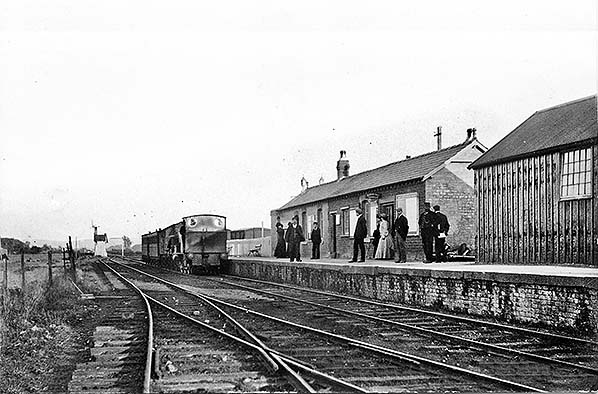 Pilling station looking east sometime between 1903 and 1908 when it was still the western terminus of the line. A train is seen arriving at the station. The brick station building was added in 1903.
Pilling station looking east sometime between 1903 and 1908 when it was still the western terminus of the line. A train is seen arriving at the station. The brick station building was added in 1903.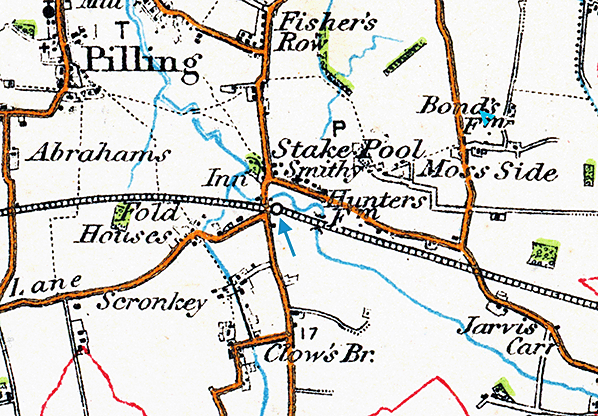
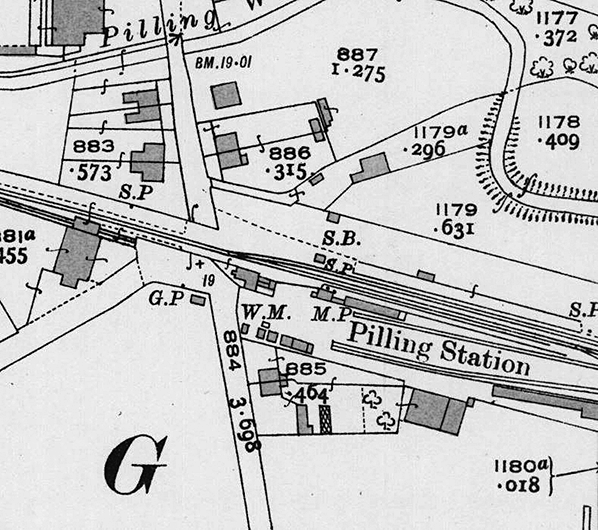
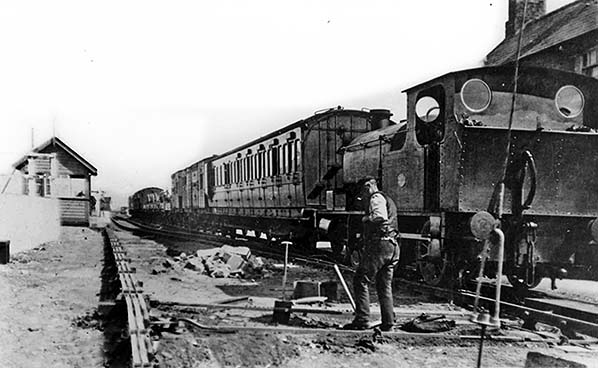 Looking east at Pilling station in 1908 during the reconstruction of the station. The new eastbound platform can be seen to the left.
Looking east at Pilling station in 1908 during the reconstruction of the station. The new eastbound platform can be seen to the left. Pilling station was located over a mile to the southeast of its namesake at the small settlement of Stakepool. The station was situated to the east of a road junction where the route from Cockerham to Knott End was joined by a minor road from Eagland Hill. There was a single platform on the south side of the line, a timber station building and a run round loop. Goods facilities were located to the south of the passenger platform and consisted of two sidings and a yard. An interesting feature was that line extended across the road for a short distance. In order to run around their trains engines had to pass onto the public highway. Whilst a crossing keeper’s house was provided, also on the south side of the line, there did not appear to be any level crossing gates in the early years.
Pilling station was located over a mile to the southeast of its namesake at the small settlement of Stakepool. The station was situated to the east of a road junction where the route from Cockerham to Knott End was joined by a minor road from Eagland Hill. There was a single platform on the south side of the line, a timber station building and a run round loop. Goods facilities were located to the south of the passenger platform and consisted of two sidings and a yard. An interesting feature was that line extended across the road for a short distance. In order to run around their trains engines had to pass onto the public highway. Whilst a crossing keeper’s house was provided, also on the south side of the line, there did not appear to be any level crossing gates in the early years. 
 On 1 July 1923 the KER was absorbed into the London Midland & Scottish Railway (LMS). Bus competition in the area had become well established by the 1920s and it had a big effect on passenger numbers. On 31 March 1930 the LMS withdrew the passenger service from the line.
On 1 July 1923 the KER was absorbed into the London Midland & Scottish Railway (LMS). Bus competition in the area had become well established by the 1920s and it had a big effect on passenger numbers. On 31 March 1930 the LMS withdrew the passenger service from the line.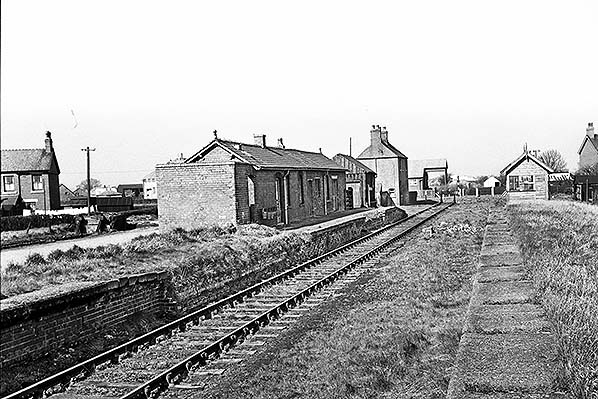 When this view of Pilling station was taken in the early 1960s the station had reverted to being the western terminus of the line. At the far end of the station the buffer stops can be seen. Prior to November 1950 trains had contined on beyond that point to reach Knott End.
When this view of Pilling station was taken in the early 1960s the station had reverted to being the western terminus of the line. At the far end of the station the buffer stops can be seen. Prior to November 1950 trains had contined on beyond that point to reach Knott End.
 Home Page
Home Page